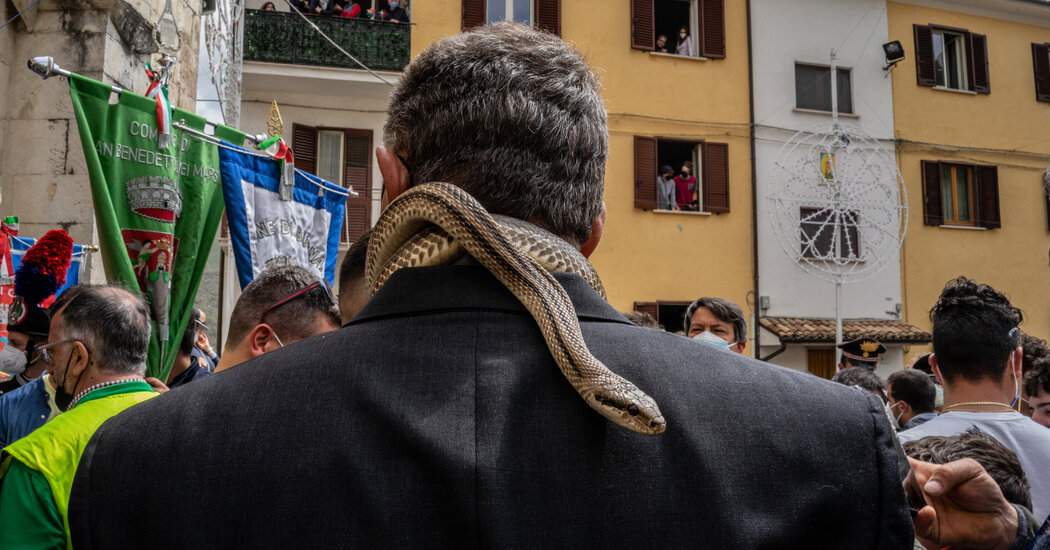It was the morning of May 1, and the Italian village of Cocullo was almost unrecognizable. The typical placidity of its quiet alleys and muted central square had given way to several thousand people: religious travelers, musicians, young women in ornate costumes, tourists from the far corners of the country and beyond.
A group of pilgrims from Atina, a town some 30 miles south, walked slowly toward the Church of Santa Maria, singing ancient religious songs and carrying a centuries-old cross. They were accompanied by bagpipe players and the town band.
It wasn’t the crowds, though, that made this gathering special. It was the snakes.
At every corner, someone was handling one of the animals, which slithered across their hands and arms. The boys and girls of the village took turns showcasing the creatures to small groups of people who crowded around to take pictures and ask questions.
At noon, silence fell over the scene, and a large figure, carved from wood, emerged: the statue of San Domenico. In front of the church, people began draping the figure with snakes.
At last we reached the moment that had drawn me here: The statue, wrapped in serpents, was lifted into the air above the captivated crowd — and the centuries-old ritual was underway.
I had arrived in Cocullo — a medieval village in the Abruzzo region — four days earlier with the photographer Elisabetta Zavoli to document the Rito dei Serpari, or the Rite of the Snake Charmers. The Catholic celebration, which takes place each year on May 1, is held in honor of San Domenico, who is credited with removing snakes from local farmers’ fields. Many historians, however, believe that its roots lie in the ancient worship of a goddess named Angitia, known for her association with the animals.
Despite the obscurity of its origins, the Cocullo festival is plainly a holdover from snake-based mystical practices that, thousands of years ago, were widespread in central and southern Italy. And since the beginning of the 20th century, the ritual has become a tourist attraction, drawing visitors who are interested in its folklore as much as its religion ties.
In the days leading up to the festival, Elisabetta and I joined a handful of local “serpari” — the term used to describe the local snake catchers and charmers — on their hunts to catch the animals used in the procession.
Marco Ognibene Mascioli, a 38-year-old soldier stationed in Bologna, was one of them. On his annual trip to Cocullo to fulfill his duties as a serparo, Mr. Mascioli led us to his favorite place in the surrounding mountains: the limestone cliffs where he often finds four-lined snakes (Elaphe quatuorlineata), a nonvenomous species that can grow to more than six feet long.
The search was slow and deliberate; we remained as quiet as possible while overturning rocks and peering into thick brush. In the end, Mr. Mascioli found only one snake — though it was large enough to be a candidate for the few that would be placed on the statue of San Domenico.
Children also take on the duties of the serpari. With Francesco Zinatelli and Valeria Del Rosso, two young friends, we went to look for snakes at an abandoned shed on the outskirts of the village. In the stone basement, they searched overhead and used sticks to coax a snake out from among the wooden floorboards. The pair later headed home with three green whip snakes (Hierophis viridiflavus).
One evening, Elisabetta and I dined at the home of Antonietta d’Orazio, who, along with Clelia and Iosella, her sisters, was encouraged to become a serpara by their mother, Maria, who introduced them to the charms of snakes as children.
We stayed at Ms. d’Orazio’s home late into the evening, chatting with her and Dalila, her daughter, in a digressive conversation that carried us into the depths of the tradition.
Her father, Ms. d’Orazio said, disliked snakes and conducted periodic searches of the house to be sure his daughters weren’t harboring the animals. To conceal their obsessions, the sisters began to hide the snakes in their beds, sheltering them there for weeks on end.
Some 15 years ago, two researchers — Gianpaolo Montinaro and Ernesto Filippi — realized the scientific potential of Cocullo’s passion for snakes, beginning a study to monitor the animals’ populations.
In the days preceding the festival, we watched as the serpari brought their snakes to a research space that was set up in a local building. There, herpetologists took body measurements and swabbed the animals to check for infections. In some cases, they inserted subcutaneous microchips.
Over the years, data collected from hundreds of specimens has contributed to several published studies on the distribution and conservation strategies of local species — four-lined snakes in particular. This citizen science project has raised awareness of the often demonized — and widely feared — animals.
And so what was once a strictly religious rite has now become so much more: a community event, a tourist draw, an open-air laboratory.
For Ms. d’Orazio, the festival offers something else, too: a chance for people to confront their phobias. Knowledge is an ally, she told me; many people here have overcome their fears.
And though she no longer hunts for the snakes herself, she takes pride as another generation embraces the festival.
“We leave it to the children now,” she said with a smile, her daughter seated beside her in the dim light of her kitchen.
Elisabetta Zavoli is a documentary photographer from Rimini, Italy. You can follow her work on Instagram.
Francesco Martinelli is a science writer from a village in the Marche region of Italy. You can follow his work on Instagram.











